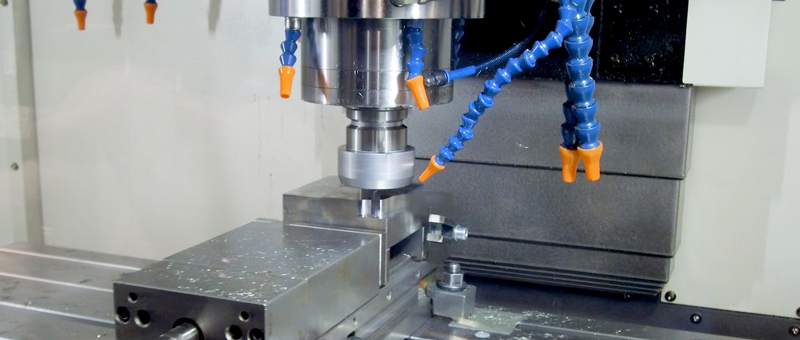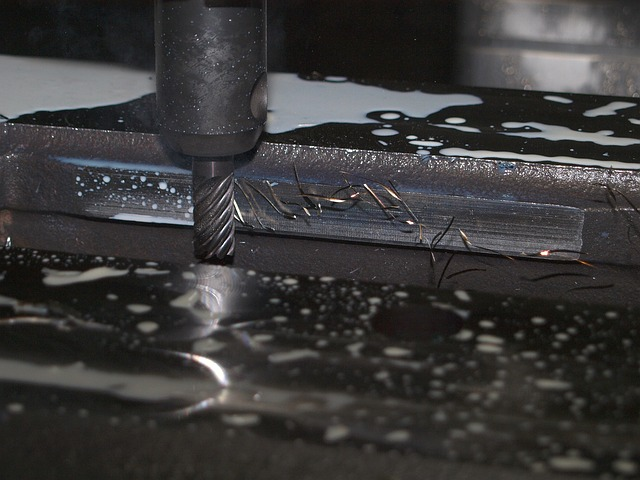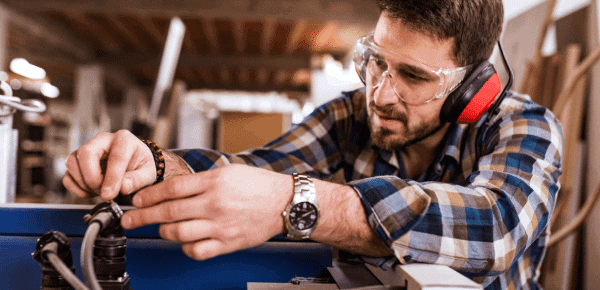A CNC lathe is one of the most widely used CNC machine tools. It is mainly used for cutting inner and outer cylindrical surfaces of shaft parts or disc parts, inner and outer conical surfaces of arbitrary taper angles, complex rotating inner and outer surfaces, and cylindrical and conical threads, etc., and can perform grooving, drilling, reaming, and reaming. Holes and borings, etc.

The CNC machine tool automatically processes the parts to be processed according to the pre-programmed processing program. We write the machining process route, process parameters, tool motion trajectory, displacement, cutting parameters, and auxiliary functions of the part into a machining program list according to the instruction code and program format specified by the CNC machine tool, and then record the content of the program list.
On the control medium, it is then input into the numerical control device of the numerical control machine tool, thereby directing the machine tool to process the parts.
Traditional machining is done by manual operation of ordinary machine tools. During machining, mechanical tools are shaken by hand to cut metal, and calipers and other tools are used to measure the accuracy of products.
Modern industries have already used computer numerically controlled machine tools for the operation, and CNC machine tools can automatically process any product and component directly according to the program pre-programmed by technicians. This is what we call CNC machining.
CNC machine tool is the abbreviation of digital control machine tool, which is an automatic machine tool equipped with a program control system. The control system can logically process the program specified by the control code or other symbolic instructions, and decode it, so as to make the machine tool move and process the parts.
Compared with ordinary machine tools, CNC machine tools have the following characteristics:
1. High processing precision and stable processing quality;
2. Multi-coordinate linkage can be carried out, and parts with complex shapes can be processed;
3. When the machining parts are changed, generally only the NC program needs to be changed, which can save production preparation time;
4. The machine tool itself has high precision and rigidity and can choose favorable processing amount, and the productivity is high (generally 3~5 times that of ordinary machine tools);
5. The machine tool has a high degree of automation, which can reduce labor intensity;
6. Higher quality requirements for operators and higher technical requirements for maintenance personnel.
The CNC lathe is composed of a CNC device, bed, spindle box, tool post feed system, tailstock, hydraulic system, cooling system, lubrication system, chip conveyor, and other parts.
CNC lathes are divided into two types: vertical CNC lathes and horizontal CNC lathes.
Vertical CNC lathes are used for turning disc parts with large turning diameters.
Horizontal CNC lathes are used for turning long or small disc parts in axial size.
Horizontal CNC lathes can be further divided into economical CNC lathes, ordinary CNC lathes, and turning centers according to their functions.
Economical CNC lathe: a simple CNC lathe formed by transforming the turning feed system of an ordinary lathe by using a stepping motor and a single-chip microcomputer. The cost is low, the degree of automation and functions are relatively poor, and the turning accuracy is not high, and it is suitable for turning rotary parts with low requirements.
Ordinary CNC lathe: It is specially designed in structure according to the requirements of turning to process, and is equipped with a general CNC system. The CNC system has strong functions, a high degree of automation, and high machining accuracy, and is suitable for turning general rotary parts. This CNC lathe can control two coordinate axes at the same time, namely the x-axis and the z-axis.

Turning machining center: On the basis of ordinary CNC lathes, the C axis, and power head are added. More advanced machine tools also have tool magazines that can control three coordinate axes of X, Z, and C. The linkage control axis can be (X, Z), (X, C), or (Z, C). Due to the addition of the C-axis and milling power head, the processing function of this CNC lathe is greatly enhanced.
Hydraulic chuck and hydraulic tailstock
A hydraulic chuck is an important accessory for clamping workpieces during CNC turning. Common hydraulic chucks can be used for general rotary parts; special chucks are required for parts whose clamped parts are not cylindrical; Spring chucks are required when machining parts.
CNC lathes can be equipped with two tool holders:
①Special tool holder: It is developed by the lathe manufacturer itself, and the tool holder used is also dedicated. The advantage of this tool holder is that it is cheap to manufacture, but it lacks versatility.
②Universal tool holder: The tool holder is produced according to certain general standards (such as VDI, German Association of Engineers), CNC lathe manufacturers can choose and configure it according to the functional requirements of CNC lathes.
Milling power head
After installing the milling power head on the CNC lathe tool holder, the processing capacity of the CNC lathe can be greatly expanded. Such as axial drilling and milling of axial grooves with a milling power head.

CNC machines are available with programs that include numbers and letters, which can help to navigate parts around various distances. A machine programming language may be implemented on Gcode or a specialized language developed in manufacturing. Basic mills consist of three wheel-based systems (XY - Z) however newer mills may contain three more wheels in addition.
When turning parts on a CNC lathe or turning machining center, the position of the tool on the tool holder should be reasonably and scientifically arranged according to the tool holder structure of the lathe and the number of tools that can be installed, and attention should be paid to avoid the tool being stationary and working. Interference phenomenon with machine tools, tools and workpieces, and tools.
The host is the main body of the CNC machine tool, including the machine body, column, spindle, feed mechanism, and other mechanical components. It is a mechanical part used to complete various cutting operations.
The numerical control device is the core of the numerical control machine tool, including hardware (printed circuit board, CRT display, key box, paper tape reader, etc.) and corresponding software, which is used to input the digital part program and complete the storage of input information and data storage. Transform, interpolate, and implement various control functions.
The drive device is the drive component of the CNC machine tool actuator, including the spindle drive unit, the feed unit, the spindle motor, and the feed motor. He realizes the spindle and feed drive through the electric or electro-hydraulic servo system under the control of the numerical control device. When several feeds are linked, the processing of positioning, straight line, plane curve, and space curve can be completed.
Auxiliary devices, some necessary supporting components of the index control machine tool, to ensure the operation of the CNC machine tool, such as cooling, chip removal, lubrication, lighting, monitoring, etc. It includes hydraulic and pneumatic devices, chip removal devices, exchange tables, CNC turntables, and CNC indexing heads, as well as tools and monitoring and testing devices.
The lifting and positioning of the machine tool should use the special lifting tools provided by the manufacturer, and other methods are not allowed. No special hoisting tools are required, and steel wire ropes should be used to hoist and position according to the specified parts of the manual.
The machine tool should be installed on a solid foundation, and the location should be away from the vibration source; avoid sunlight and heat radiation; place it in a dry place to avoid the influence of moisture and airflow. If there is a vibration source near the machine tool, an anti-vibration trench must be set around the foundation.
The machine tool is placed on the foundation, it should be leveled in a free state, and then the anchor bolts are evenly locked. For ordinary machine tools, the level reading does not exceed 0.04/1000mm, and for high-precision machine tools, the level does not exceed 0.02/1000mm.
When measuring the installation accuracy, it should be carried out at a constant temperature, and the measuring tool should be used after a period of constant temperature. When installing the machine tool, try to avoid installation methods that force the machine tool to deform. When the machine tool is installed, some parts of the machine tool should not be removed casually. The removal of the parts may lead to the redistribution of the internal stress of the machine tool, thus affecting the accuracy of the machine tool.
After the geometric accuracy of the machine tool has passed the inspection, the whole machine needs to be cleaned. Use cotton or silk cloth soaked with the cleaning agent, not cotton or gauze. Clean off the anti-rust oil or anti-rust paint applied to protect the guide rail surface and the machined surface when the machine tool leaves the factory. Clean the dust from the outer surface of the machine tool. Coat each sliding surface and working surface with lubricating oil specified by the machine tool.
Carefully check whether all parts of the machine tool are oiled as required and whether enough coolant is added to the cooling box. Whether the oil of the hydraulic station of the machine tool and the automatic lubricating device has reached the specified position of the oil level indicator.
Check whether the switches and components in the electrical control box are normal and whether the integrated circuit boards are in place.
Turn on the power and start the centralized lubrication installation, so that the lubricating parts and the lubricating oil circuit are filled with lubricating oil. Do all the preparations before the action of each part of the machine tool.
Since CNC lathe processing is a high-precision work, its processing procedures are concentrated and the number of parts clamping is small, which puts forward higher requirements for the CNC tools used. The following Dongguan Tongli Metal Products Co., Ltd. is here for you. introduce.
When choosing tools for CNC machine tools, the following aspects should be considered:
① The type, specification, and precision grade of CNC tools should be able to meet the processing requirements of CNC lathes.
②High precision. In order to meet the requirements of high precision and automatic tool change of CNC lathe processing, the tool must have high precision.
③High reliability. To ensure that accidental tool damage and potential defects do not occur in CNC machining and affect the smooth progress of machining, it is required that the tool and the accessories combined with it must have good reliability and strong adaptability. Precision metal processing
④High durability. The tools processed by CNC lathes, whether in roughing or finishing, should have higher durability than those used in ordinary machine tools, so as to minimize the number of replacement or grinding tools and tool settings, thereby improving the processing of CNC machine tools. Efficiency and guaranteed processing quality.
⑤ Good chip breaking and chip evacuation performance. In CNC lathe processing, chip breaking and chip removal cannot be handled manually like ordinary machine tools.
The chips are easy to wrap around the tool and the workpiece, which will damage the tool and scratch the machined surface of the workpiece, and even cause injuries and equipment accidents. , affecting the processing quality and the safe operation of the machine tool, so the tool is required to have good chip breaking and chip removal performance.
In hardware processing, all rotary parts that can be clamped on an ordinary lathe can be processed on a CNC lathe. However, CNC lathes have the characteristics of high machining accuracy, linear and circular interpolation, and automatic speed change in the process of hardware processing, and their technological scope is much wider than that of ordinary machine tools.
The CNC lathe has good rigidity, high manufacturing, and tool setting accuracy, and can easily and accurately enter manual compensation and automatic compensation. Therefore, it can process parts with high dimensional accuracy requirements.
In addition, the tool movement of CNC turning is realized by high-precision interpolation movement and servo drive.
In addition, the rigidity of the machine tool is good and the manufacturing precision is high. Therefore, it can process the shape accuracy of the busbar straightness, roundness, cylindricity, etc. Demanding parts. For arcs and other curved profiles, the machined shape is much closer to the geometry required on the drawing than with a copy lathe.
The CNC lathe has a constant line speed cutting function, so the optimal line speed can be used to cut the tapered surface and the end surface, so that the surface roughness value after turning is small and consistent, and the parts with small and uniform surface roughness value can be processed.

The location of the machine tool should be far away from the vibration source, direct sunlight and thermal radiation should be avoided, and the influence of humidity and airflow should be avoided. If there is a vibration source near the machine tool, anti-vibration grooves should be set around the machine tool.
Otherwise, it will directly affect the machining accuracy and stability of the machine tool, which will cause poor contact with the electronic components, failure, and affect the reliability of the machine tool.
Generally, CNC lathes are installed in the machining workshop, not only does the ambient temperature change greatly, and the use conditions are poor, but also there are many mechanical and electrical equipment, resulting in large fluctuations in the power grid. Therefore, the location where the CNC lathe is installed requires strict control of the power supply voltage. Power supply voltage fluctuations must be within the allowable range and remain relatively stable. Otherwise, the normal operation of the CNC system will be affected.
The ambient temperature of the CNC lathe is lower than 30 degrees Celsius, and the relative temperature is less than 80%.
Generally speaking, there is an exhaust fan or a cooling fan inside the CNC electric control box to keep the working temperature of the electronic components, especially the central processing unit, constant or the temperature difference changes very little.
When using the machine tool, the user is not allowed to change the parameters set by the manufacturer in the control system at will. The setting of these parameters is directly related to the dynamic characteristics of each component of the machine tool. Only the backlash compensation parameter values can be adjusted according to the actual situation.
The user cannot change the accessories of the machine tool at will, such as using the hydraulic chuck beyond the specification. The manufacturer fully considers the matching of various link parameters when setting accessories. Blind replacement results in a mismatch of parameters in various links, and even cause unexpected accidents.
The pressure of the hydraulic chuck, hydraulic tool rest, hydraulic tailstock, and hydraulic cylinder should be within the allowable stress range, and it is not allowed to increase arbitrarily.
CNC lathe is a high-precision, high-efficiency automatic machine tool. Equipped with a multi-station turret or a power turret, the machine tool has a wide range of processing performance, which can process linear cylinders, oblique cylinders, arcs, and various threads, grooves, worms, and other complex workpieces, with linear interpolation, arc Interpolate various compensation functions, and play a good economic effect in the mass production of complex parts. The maintenance of the CNC lathe with the inclined bed is as follows:
In order to ensure the working accuracy of the CNC lathe with an inclined bed and prolong the service life, it is necessary to carry out reasonable maintenance work on the CNC lathe with an inclined bed for self-use.

In order to use CNC lathes one must be able to successfully complete a specified amount of courses and obtain appropriate certification. CNC turning machining programs usually include multiple class sessions that offer a gradual instruction program split into several sections. Throughout the training, a safety protocol should be respected. Beginning machining classes can be difficult without practical experience, but they can help familiarize the students with the commands in CAD files and CAD programming.
